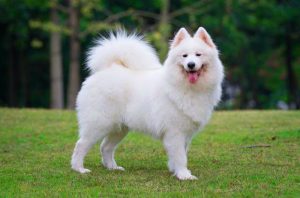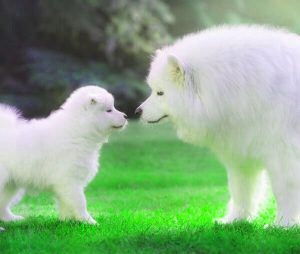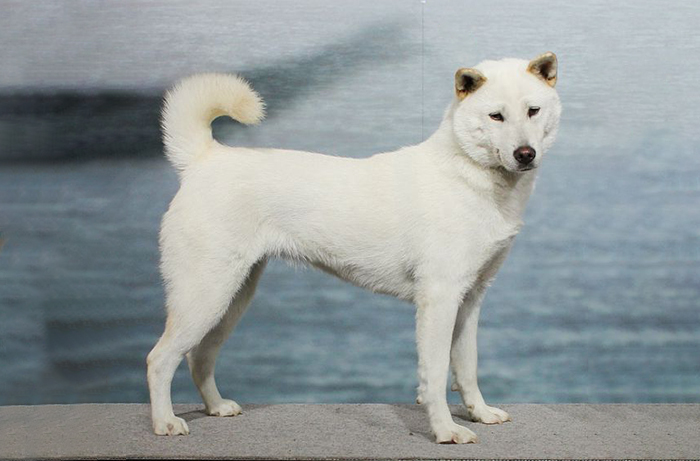Menu
SAMOYED
friendly, gentle and dependableJust fill out your Name and the Email.
The message has already been written.
Note: We will send you a confirmation email right after you submit it. If you haven’t seen the confirmation email within 5 minutes even in spam. That means your typed email address has a typo. Please re-confirm your email and re-send it to us.
Some FAQs about Samoyed
The Samoyed is a friendly, personable dog. These are intelligent dogs, with a touch of independence. Bred to live in a tent in very close quarters with their families, they thrive on human company. Samoyeds will alarm bark and, if left alone for long periods of time, will often develop into nuisance barkers.
Samoyeds are such friendly dogs and they often love being in a family environment. With the right socialisation, they are usually great with children and will be very loyal to the whole family – although they may sometimes favour one chosen person.
Generally, a Samoyed puppy will get along well with other pets, including cats. They’re also good around young children, as long as you don’t mind when their herding instinct kicks in. The ideal home for a Samoyed puppy is one that puts him to work—Samoyeds thrive when given a job.
FUN FACT: The Samoyed’s mouth has upturned corners so these beautiful dogs always look like there are happy and smiling. This Samoyed’s recognizable smile has a practical historical function – upturned corners of the mouth keep the Samoyed from drooling, preventing icicles from forming on the face.
Samoyed are not as challenging to care for as some breeds, but they are not beginner dogs. Samoyed care is of a medium to difficult level. They require a lot of exercise, grooming, consistent training, and plenty of engagement and entertainment to keep them occupied.
They have a jolly “sense of humor” and often exhibit it when disobeying. The Samoyed barks a LOT, and some individuals have high-pitched, extremely piercing voices. A Samoyed may be right for you.
12 – 14 years
On average, Samoyed puppies sleep between 15 and 20 hours a day, and adult Samoyeds sleep between 10 and 14 hours a day. This requires giving them enough exercise and sticking to a routine, but when done correctly you’ll have a nice, sleepy dog at the times you want them to be.
The Samoyed is a playful, alert breed that excels as both a family dog and a guard dog.
How to buy Samoyed in Japan?
STEP 1: Contact Us via:
To get the fastest response, we recommend you message us via Whatsapp.
STEP 2: Tell us you want a Samoyed and we are happy to hear more about other details like: gender, coat color, your expense, and your special request if you have one.
To save time, let fill out the form below with something like: Hello! or I need a dog. and that is enough to start our good cooperation.
*Please Note: It is difficult to know which breeder is trustworthy when you are in another country. But fortunately there are reputable associations that can guarantee the quality of breeders who are members of their association. These can be mentioned as Japan Kennel Club – JKC, The Kennel Club of Japan – KC or Nihonken Hozonkai – 日保 and many other associations (JABC, JCC, ICC, CPRO, JCU, KCP, ACC, CCJ, KCC, NMSA, WCA, JMSA, ZCC). Dogs and Cats sold by breeders belonging to these associations are always accompanied by a pedigree certificate.
JP-Pets will act on your behalf, carry out the necessary export procedures quickly, accurately and professionally to ensure that the dog can be delivered to your hands. About exporting methods, you can see more here: Exporting Methods.
Talk to us and get a free consultation from our experts.
SAMOYED
Samoyed
Developed centuries ago by the nomadic Samoyed people of Siberia, this beautiful dog was used for herding and guarding reindeer and for sled-hauling. This tough, outdoor worker was also very much a family dog, taking its place in its owner’s tent and enjoying human companionship. These dogs were brought to England in the 1800s and were first seen in the United States around a decade later. Numerous myths and unsubstantiated stories link the Samoyeds to the polar expeditions of the late 19th and early 20th centuries, but it appears likely that this breed was included among sled teams taken to the Antarctic during the heyday of polar exploration.

The modern Samoyed retains the sociable and easy-going temperament that made it so valued as part of a nomadic family. Behind the “smiling” expression characteristic of the breed is an affectionate nature and a desire to be friends with everyone. However, the Samoyed retains the watchdog instincts for which it was bred. Although never aggressive, it will bark at anything that arouses its suspicion. This dog craves company and likes to be kept occupied mentally and physically. Intelligent and spirited, a bored or lonely Samoyed will resort to mischief – whether it is digging holes or finding a way to escape through a fence. The breed responds well to thoughtful handling, but training requires patience and persistence on the part of its owner. Daily grooming is essential to keep the Samoyed’s magnificent, stand-out coat in order and maintain its distinctive silvery sheen. Seasonal shedding of the undercoat can be very heavy but, except in very warm conditions, normally occurs only once a year.

The Breed History
In ancient times, the early ancestral dogs of the Samoyed breed likely moved with migrating tribes from Iran through Mongolia to the Northwestern Siberian tundra. There they helped the Samoyede people in many ways, and were welcomed as family members into their nomadic dwellings. They were first brought to England in the late nineteenth century. The first dog was registered with AKC in1906.
Physical Characteristics

Height at Withers:
Female 19-21” (48-53 cm)
Male 21-23.5” (53-60 cm)
Weight: 50-65 lb (23-29.5 kg).
Coat: The double coat is profuse, heavy and very resistant to the elements. Males have a particularly well-developed lion’s type ruff. The undercoat is soft, short and wooly while outer hairs are straight, stand out from the body and are glistening silvery-white. Some dogs have a creamy or biscuit color.
Longevity: 12 years
Recognized Behavior Issues and Traits

Reported breed characteristics include: Loyal guardian of home and family, not argumentative with other dogs generally, require lots of exercise, playful, curious, high grooming needs, tend to pull on leash; need early obedience training, gentle and intelligent but with an independent streak. Good with children. Need close human companionship, tolerate weather extremes well, particularly the cold. If not mentally or physically active and challenged, or given adequate time with family, they may become destructive. They have a high pitched bark.
Looking for more of other Dog breed information
JAPANESE TERRIER independent, active, crisp, and lively I <3 Japanese Terrier! The quick message here! Just …
HOKKAIDO DOG skilled hunter, devoted companion and trustworthy watchdog I <3 Hokkaido Dog! The quick messag …
SHIKOKU INU intelligent, loyal and alert I <3 Shikoku Inu! The quick message here! Just fill out your Name …
…
BERNESE MOUNTAIN DOG sweet, calm and easygoing I <3 Bernese Mountain Dog! The quick message here! Just fill …
<a class="" …






